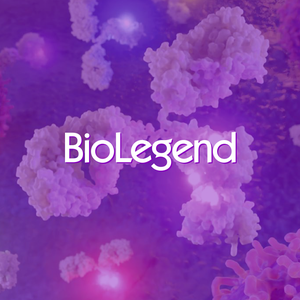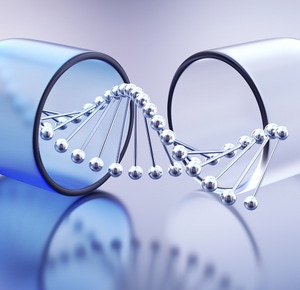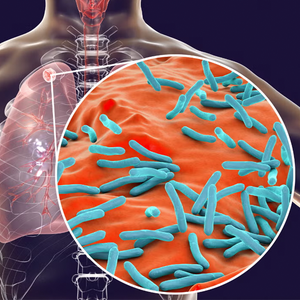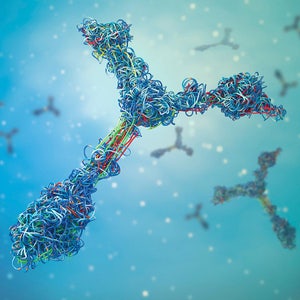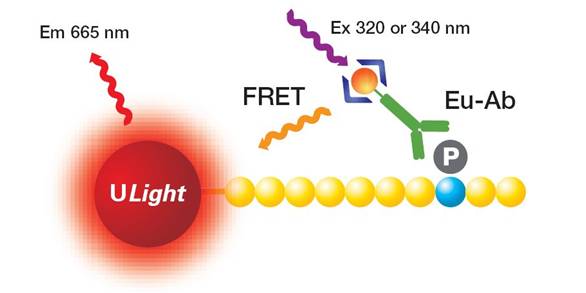
Assay Principle
LANCE™ (Lanthanide chelate excite) and LANCE™ Ultra are our TR-FRET (time-resolved fluorescence resonance energy transfer), homogeneous (no wash) technologies. One molecule of interest is labeled with a donor fluorophore (a LANCE Europium chelate) and the second molecule is labeled with an acceptor fluorophore [ULight™ dye, allophycocyanin (APC), Cy5, etc.]. Upon excitation at 320 or 340 nm, energy can be transferred from the donor Europium chelate to the acceptor fluorophore if sufficiently close for FRET (~10 nm). This results in the emission of light at 665 nm (for ULight dye and APC).

Figure 1. Example of detection of a phosphorylated substrate in a LANCE Ultra kinase assay, using a Europium-labeled anti-phospho antibody and a ULight-labeled peptide substrate.
Donor and Acceptor Fluorophores
LANCE Ultra uses a LANCE Europium chelate donor fluorophore and a ULight dye acceptor fluorophore. In addition to our standard ULight dye-labeled catalog products, we also provide custom ULight dye labeling services. We also carry standard LANCE Europium catalog products and LANCE Europium labeling reagents, and we can provide custom LANCE Europium labeling services.
LANCE uses a LANCE Europium chelate donor fluorophore and a SureLight™ allophycocyanin (APC) acceptor fluorophore. In addition to our standard LANCE Europium and SureLight APC catalog products, we carry LANCE Europium labeling reagents for those who wish to label their own biomolecules. We also provide custom labeling services.
Our LANCE Eu-W1024 chelate is the preferred LANCE chelate and gives excellent S:B in LANCE assays. The LANCE Eu-W8044 chelate is more-stable for unusual applications (resistant to higher concentrations of EDTA and other chelators in the assay, and stable at assay temperatures above 38°C).
Please note that DELFIA™ Europium reagents will not work in TR-FRET assays.
Recommended LANCE Donor and Acceptor Fluorophores
| Donor or Acceptor | Fluorophore | Residual Molecular Weight |
|---|---|---|
| Donor | LANCE Eu-W1024-ITC | 697 Da |
| Donor | LANCE Eu-W8044-DTA | 960 Da |
| Acceptor | LANCE ULight dye | < 800 Da |
| Acceptor | SureLight APC dye | ~102,000 Da (102 kDa) |
Assay Features
- 96-, 384-, and 1536-well formats
- Homogeneous (no wash) assay - mix components in well and read
- Uses a microplate suitable for fluorescence (we recommend white OptiPlates™ or white ProxiPlates™)
- Most commonly used for biochemical assays with purified reagents; LANCE cAMP and others are cell-based assays; demonstrated cell membrane and cell lysate applications
- Can be used in HTS screening
- Can be automated
Applications
- Kinase assays
- cAMP assays
- Protein:protein interaction assays
- Epigenetic assays
- Phosphatase assays
- Label your own LANCE reagent
Products and catalog numbers
View a listing of relevant products and catalog numbers for LANCE assays.
Instrument Options Settings
LANCE and LANCE Ultra assays require a microplate reader that is capable of time-resolved fluorescence. We recommend filter-based fluorometers, though monochromator instruments can be used. Use of monochromator instruments may result in decreased assay sensitivity. We recommend using Revvity's VICTOR™ X, ViewLux™ (for high throughput), or EnVision™ Multilabel Plate Reader. Please check that you have the correct filters for this assay. If you are using an instrument manufactured by another company, we recommend that you contact their technical support team to see if they have optimized settings, filter recommendations, etc. for a LANCE TR-FRET assay.
Use an excitation wavelength of 320 or 340 nm to excite the LANCE Europium chelate. We recommend you read this assay in dual emission mode, detecting both the emission from the Europium donor fluorophore at 615 nm, and the acceptor fluorophore (at 665 nm for APC, ULight dye, and Alexa Fluor 647). The raw FRET signal at 665 nm can be used to process your data. The ability to analyze the signal at 615 nm can be helpful when troubleshooting.
Recommended Instrument Settings for the LANCE cAMP Assay
| Parameter | VICTOR | EnVision | ViewLux | EnSpire™ TRF Option |
|---|---|---|---|---|
| Flash Energy Area | High | n/a | n/a | |
| Flash Energy Level | 150 | 100% | 600,000 | |
| Excitation Filter | 320/340 | UV2 320 | DUG11 (UMB,AMC) | UV2 320 |
| Integrator Cap | 3 | n/a | n/a | |
| Integrator Level | 2x LANCE High Count 615 | n/a | n/a | |
| Emission Filter | 1) 615 nm | 1) 203 - Eu 615 | 1) 618/8 (Eu) | 1) 615 nm** |
| Emission Filter | 2) 665 nm | 2) 205 - APC 665 | 2) 671/8 (LANCE) | 2) 665 nm** |
| Delay Time | 50 µs | 60 µs | 50 µs | 60 µs |
| Readout speed, gain and binning | n/a | n/a | Medium, High, and 2x | |
| Number of Flashes | n/a | 100 | n/a | |
| Window | 100 µs (200 µs) | 100 µs (200 µs) | 354 µs | 200 µs |
| Mirror module | n/a | 462 (D400/D630) or 412 (D400) | n/a | |
| Cycle | 2000 µs | 2000 µs | n/a |
Recommended Instrument Settings for the LANCE Ultra Kinase Assay
| Parameter | VICTOR | EnVision | ViewLux* | EnSpire™ TRF Option |
|---|---|---|---|---|
| Flash Energy Area | High | n/a | n/a | |
| Flash Energy Level | 150 | 100% | 800,000 | |
| Excitation Filter | 320/340 | UV 320/340 | DUG11 (UMB, AMC) | UV2 320 |
| Integrator Cap | 2 (or 3**) | n/a | n/a | |
| Integrator Level | 2x the setting in LANCE High Count 615 label | n/a | n/a | |
| Emission Filter | 1) 615 nm | 1) 203 - Eu 615 | 1) 618/8 (Eu) | 1) 615 nm** |
| Emission Filter | 2) 665 nm | 2) 205 - APC 665 | 2) 671/8 (LANCE) | 2) 665 nm** |
| Delay Time | 50 µs | 90 µs | 50 µs | 60 µs |
| Readout speed, gain and binning | n/a | n/a | medium, high, and 2x | |
| Measurement Time | n/a | 100 (200***) flashes | 20 s exposure time | |
| Window | 100 µs (200-300 µs***) | 100 µs (200-300 µs***) | 354 µs | 200 µs |
| Mirror module | n/a | 402/412 (D400) or 452/462/662 (D400/D630) | Mirror 2 (UV dichroic) | |
| Cycle | 1000 µs | 2000 µs | n/a |
* ViewLux with flat field correction, bias correction, cosmic ray detection, excitation energy compensation
** The EnSpire Multi-Label plate reader uses monochromator-based emission. The wavelengths given represent the monochromator settings. The measurement is carried out first with one monochromator setting for the whole plate, then with the second monochromator setting in a subsequent measurement step.
*** If signal too low with 2 or 100
- Laser settings for LANCE assays on an EnVision
Delay: 50 µs (you could measure delay 10µs to get slightly improved S/B)
Window time: 100 µs (it is important not to use too long window time)
Time between flashes: 16600 µs
Focus height: 6.5 mm
Tips
See under each Application for tips and FAQs specific to your assay.
- You must remove the Seal™-A or any other plate seal prior to reading a LANCE assay.
General FAQs
Q. Can I use DELFIA Europium reagents in a LANCE TR-FRET assay?
A. No, this is not possible. The DELFIA Europium chelate is not fluorescent until you add Enhancement solution or another DELFIA dissociating reagent. This dissociation step releases the lanthanide from the biomolecule it is attached to, and allows it to form a new chelate that is highly fluorescent, floating free in solution. In a TR-FRET assay, you cannot allow the lanthanide to dissociate from the biomolecule it is attached to - it would ruin your FRET assay.
For research use only. Not for use in diagnostic procedures.
The information provided above is solely for informational and research purposes only. Revvity assumes no liability or responsibility for any injuries, losses, or damages resulting from the use or misuse of the provided information, and Revvity assumes no liability for any outcomes resulting from the use or misuse of any recommendations. The information is provided on an "as is" basis without warranties of any kind. Users are responsible for determining the suitability of any recommendations for the user’s particular research. Any recommendations provided by Revvity should not be considered a substitute for a user’s own professional judgment.
Custom Labeling and Assay Development Services
Revvity offers custom labeling services as well as custom assay development. To learn more about having your biomolecule custom-labeled, or to to inquire about custom assay development, please contact our custom teams:
Custom Assay Development Services.


